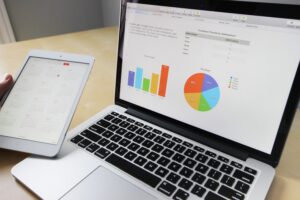Table of Contents
ToggleWhat Is Quantitative Trading?
Quantitative trading incorporates technology, math, and the availability of extensive databases, among other things, to make rational trading decisions. Traders use mathematical models to predict future price movements based on current conditions. They build a model of the market and optimize it using historical data. Then they implement the model in real-time markets using real capital.
The most popular types of quantitative trading include trend following, mean reversion, momentum, divergence, and volatility trading. Trend following uses simple rules to buy stocks that are rising and sell those that are falling. Mean reversion looks for assets that are trending one way and selling in the opposite direction. Momentum trades focus on buying high performers and selling low performers. Divergence trading looks for stocks that are moving together and selling separately. Finally, volatility trading focuses on identifying stocks that are moving together because they are correlated with each other.
A more advanced method of quant trading is developing complex algorithms that combine mathematical models into more intricate trading rules.
Why Is Quantitative Trading Used?
Quantitative trading is used to automate the process of decision-making in trading. The strategy allows traders to make decisions based on quantitative data rather than relying on intuition or emotions. Quantitative trading techniques also allow traders to access larger amounts of data than traditional methods.
Quantitative analysis improves the ability of traders to identify and capitalize on opportunities in the markets quickly. As a result, quantitative active trading strategies can help traders to identify profitable trading opportunities and minimize risk. They can also help a human trader make decisions more quickly, real time spent analyzing markets, and minimize slippage costs. Additionally, quantitative trading strategies can be used to evaluate the performance of a trading strategy over time, allowing traders to make informed decisions about their trading strategies and optimize them for the current market conditions.
Additionally, quantitative trading minimizes the role of discretionary or emotional decision-making. While certain traders rely on their ‘gut’, quantitative traders rely on mathematical models for identifying trading opportunities.
Advantages and Disadvantages of Quantitative Trading
Advantages:
1. Increased trading accuracy: Quantitative trading strategies rely on data and algorithms to automatically identify and capture trading opportunities. Because these technical analysis strategies are automated, they are often more accurate than manual trading methods. This increased accuracy can lead to more consistent trading results.
2. Lower transaction costs: Quantitative trading strategies can be executed quickly and more efficiently than manual trading strategies. This allows for lower transaction costs, as brokers may offer discounts for larger orders or for orders sent directly to the market.
3. Lower emotional errors: Quantitative trading strategies are based on data and algorithms and do not involve investor sentiment. More rational and consistent trading decisions reduce impulsive decisions possibly fueled by fear or greed.
Disadvantages:
1. High capital requirements: Quantitative trading strategies often require a large amount of capital to test and develop models. They may require more capital for success. This can be a major barrier to entry for smaller traders or first-time investors as advanced quant strategies require long history to ensure they can manage different market conditions.
2. Increased risk: Quantitative trading strategies can be highly complex and carry a higher risk level risk than manual trading methods.
3. Black box algorithms: Quantitative trading strategies rely on complex algorithms that are often difficult to understand. This can lead to a lack of transparency, as traders may not be able to understand how the algorithms work.
How Has Quantitative Trading Evolved?
Quantitative trading, otherwise known as algorithmic or automated trading, has evolved significantly over the past decades. It has become increasingly popular in financial markets due to its ability to generate profits quickly and efficiently. Before the 1990s, quantitative strategies for trading were limited to the largest financial institutions that used computers to perform backtesting and simulation of trades.
As technology improved and computing power increased, individual investors and hedge funds began to use quantitative trading, leading to the development of algorithmic trading platforms. The algorithmic trading systems of today are far more sophisticated and powerful than those of the past. They are capable of executing complex strategies in milliseconds while at the same time monitoring and adjusting to market conditions in real-time. It can also generate large numbers of trades, allowing for greater diversification and risk management. In addition, the advent of high-frequency trading has allowed quantitative trading strategies to become more profitable.
High-frequency traders take advantage of market microstructure inefficiency using of advanced algorithms and high-speed computers to outpace other market participants to identify and take advantage of arbitrage opportunities. Finally, the development of machine learning and artificial intelligence has enabled quantitative trading strategies to become more accurate and profitable. Machine learning algorithms now recognize and exploit market data patterns more quickly and accurately than ever before.
Quantitative vs. Algorithmic Trading
Quantitative trading is a trading strategy that uses mathematical models and formulas to identify trading opportunities. It is based on the idea prices can be predicted by analyzing past price movements and market data. Quantitative trading strategies are typically automated and are programmed into a computer that can execute trades without human intervention.
On the other hand, algorithmic trading is a form of automated trading that uses complex algorithms to identify trading opportunities in the market and execute trades automatically. Algorithmic trading strategies are more complex and account for various factors, such as market sentiment, news events, and technical indicators. In addition, the algorithms used for algorithmic trading can be customized based on the trader’s preferences and goals.
Quantitative Trading Strategies
There are numerous types of quantitative strategies. Here are a few of the more popular ones
1. Trend following strategies: These strategies involve taking positions in assets that are either trending up or trending down direction. These strategies reanalyze asset price movements to identify potential trading opportunities.
Examples of trend strategies include trend following, moving average crossover, and momentum trading.
2. Mean reversion strategies: These strategies attempt to exploit the tendency of asset prices to revert back to the mean or average price over a period of time. These strategies typically involve looking for deviations from the mean and taking a position in the opposite direction.
Examples of mean reversion strategies include pairs trading and contrarian trading.
3. Arbitrage strategies: These strategies attempt to explore discrepancies between different types of assets.
Examples of arbitrage strategies include triangular arbitrage, statistical arbitrage, and convergence trading.
FAQ
What does a quantitative trader do?
A quantitative trader is a professional who uses quantitative analysis and mathematical models to develop and implement trading strategies. Quantitative traders use quantitative techniques to analyze markets, identify trading opportunities, and execute trades. This type of trading is also known as algorithmic trading, as it relies on complex algorithms to identify and take advantage of market inefficiencies. Quantitative traders use a variety of methods and models to analyze markets, including statistical analysis, machine learning, and artificial intelligence. In addition, quantitative traders are typically responsible for developing and implementing automated trading strategies. These strategies are based on data analysis and mathematical models and are designed to maximize returns and minimize risks. Quantitative traders must also stay up to date on market trends and news, which can have a significant impact on their trading strategies.
Is quantitative trading profitable?
Yes, quantitative trading can be profitable. The use of quantitative trading strategies sometimes referred to as algorithmic trading, has become increasingly popular among traders and investors. Quantitative trading strategies rely on complex mathematical models and algorithms to analyze financial markets and identify trading opportunities. By automating the trading process, quantitative traceable to identify attractive trading opportunities and execute trades quickly and efficiently. Quantitative trading strategies have been employed successfully by many investors and traders. For instance, a 2019 article in the Wall Street Journal reported that quantitative trading strategy generated returners of about 15% annually over the past for fund managers’ care. Similarly, in a research paper published in 2017, researchers from the University of Pennsylvania Wharton School of Business reported that algorithmic trading strategies had produced higher returns than traditional, discretionary trading strategies in the US stock markets.
Of course, many quant strategy developers are not profitable. They can often just codify their poor trading assumptions into mathematical modeling. It’s important to have quant strategies that can survive the test of time and trading in multiple market conditions and with real-life execution. Simply hypothesizing quant models and backtesting them is not sufficient for generating profits.




